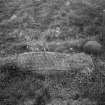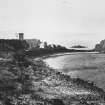Inchcolm, Hogback Stone
Hogback Stone (Early Medieval)
Site Name Inchcolm, Hogback Stone
Classification Hogback Stone (Early Medieval)
Alternative Name(s) Inchcolm Abbey
Canmore ID 50898
Site Number NT18SE 7.03
NGR NT 18883 82609
Datum OSGB36 - NGR
Permalink http://canmore.org.uk/site/50898
- Council Fife
- Parish Aberdour (Dunfermline)
- Former Region Fife
- Former District Dunfermline
- Former County Fife
Inchcolm 2, Fife, hogback monument
Measurements: H 0.36m to 0.42m, L 1.62m, W 0.20m to 0.30m
Stone type: sandstone
Place of discovery: NT 18882 82612
Present location: in the HES Visitor Centre at the harbour on Inchcolm.
Evidence for discovery: recorded in the sixteenth century on a knoll near Inchcolm Abbey, at which time it was associated with a standing cross. It remained in situ, lying north-south, until 1993 when it was moved into the Abbey.
Present condition: very weathered.
Description
Carved in relief, the ridge has a distinct convex curve and may have been ornamented, and there are end-beasts with muzzles and ears. The west side has four rows of tegulae above a panel with a central cross with expanded arms, flanked on the left by two pilasters and on the right by three, the pilasters ornamented with interlace (best seen in the RCAHMS superb photographs taken in 2014). The east side has five rows of tegulae above a panel with a central frontal figure grasping a staff or spear in each hand, flanked on the right by one double and one single pilaster with interlace ornament. To the left of the figure the carving is much defaced.
Date: mid tenth century.
References: Stuart 1956, pl 125; Simpson 1856, 495-7; ECMS pt 3, 366-7; Lang 1974, 227.
Compiled by A Ritchie 2016
Inchcolm 2, Fife, hogback monument
Measurements: H 0.36m to 0.42m, L 1.62m, W 0.20m to 0.30m
Stone type: sandstone
Place of discovery: NT 18883 82609
Present location: in HES Visitor Centre at the harbour on Inchcolm.
Evidence for discovery: recorded in the sixteenth century on a knoll near Inchcolm Abbey, at which time it was associated with a standing cross. It remained in situ, lying north-south, until 1993 when it was moved into the Abbey.
Present condition: very weathered.
Description
Carved in relief, the ridge has a distinct convex curve and may have been ornamented, and there are end-beasts with muzzles and ears. The west side has four rows of tegulae above a panel with a central cross with expanded arms, flanked on the left by two pilasters and on the right by three, the pilasters ornamented with interlace (best seen in the RCAHMS superb photographs taken in 2014). The east side has five rows of tegulae above a panel with a central frontal figure grasping a staff or spear in each hand, flanked on the right by one double and one single pilaster with interlace ornament. To the left of the figure the carving is much defaced.
Date: mid tenth century.
References: Stuart 1956, pl 125; Simpson 1856, 495-7; ECMS pt 3, 366-7; Lang 1974, 227.
Desk-based information compiled by A Ritchie 2017
NT18SE 7.03 18883 82609
(NT 1888 8260) Hogg Backed Stone (NR)
OS 6" map, Fife (1967).
This hog-backed tombstone, dated by Lang to the mid-10th c, measures 5' x 1'9" x 1', with zoomorphic ends and a weathered human figure with arms raised in prayer in the middle of the vertical E face
RCAHMS 1933, visited 1925; J W Paterson 1950; J T Lang 1975.
Field Visit (26 August 1925)
Hog-Backed Monument, Inchcolm.
On the crest of the rising knoll immediately to the west of the ruined Abbey is an interesting hogbacked monument of sandstone, lying with its main axis due north and south. The stone, which is of the usual shape, measures 5 feet in length by 1 foot 9 inches high at the middle and 1 foot in greatest width. It is rudely sculptured with zoomorphic ends and has five rows of more or less circular scaling on the sloping sides of the top, to imitate shingles, while in the middle of the vertical east face is a somewhat obliterated representation of a human figure with arms upraised in the ancient attitude of prayer.
See also Proc. Soc. Ant. Scot., ii (1854-7), p. 496; xix (1884-5), p. 417; Allen's Early Christian Monts., pp. 366-7; Anderson's Scotland in Early Christian Times, 2nd Series, p. 72.
RCAHMS 1933, visited 26 August 1925.
Field Visit (11 March 1959)
This hog-backed stone, now enclosed within low iron railings, is as described.
Visited by OS (AC), 11 March 1959.
Excavation (1993)
NT 1888 8260 To protect the hogback stone from weathering it was decided to move it indoors. In connection with this operation, archaeologists from AOC (Scotland) Ltd excavated an area 5m by 6.5m around the stone. A 16th-century reference mentions a stone cross situated near the hogback. The purpose of the excavation was to determine whether evidence for the cross survived and to examine the immediate environs of the hogback for signs of any associated features.
The stone was lying on subsoil 10cm thick, overlying bedrock. Around the stone were four pits filled with human bones, probably representing reburial of bones found during recent construction work on the island. No features were found which could be related to the monument.
Sponsor: Historic Scotland
M Dalland 1993.








































































